As stupid as this is, and possibly Sabatini knows better, it works. The idiot base laps it up and Sabatini reminds them that he exists.
Colleges
- AAC
- ACC
- Big 12
- Big East
- Big Ten
- Pac-12
- SEC
- Atlantic 10
- Conference USA
- Independents
- Junior College
- Mountain West
- Sun Belt
- MAC
- More
- Navy
- UAB
- Tulsa
- UTSA
- Charlotte
- Florida Atlantic
- Temple
- Rice
- East Carolina
- USF
- SMU
- North Texas
- Tulane
- Memphis
- Miami
- Louisville
- Virginia
- Syracuse
- Wake Forest
- Duke
- Boston College
- Virginia Tech
- Georgia Tech
- Pittsburgh
- North Carolina
- North Carolina State
- Clemson
- Florida State
- Cincinnati
- BYU
- Houston
- Iowa State
- Kansas State
- Kansas
- Texas
- Oklahoma State
- TCU
- Texas Tech
- Baylor
- Oklahoma
- UCF
- West Virginia
- Wisconsin
- Penn State
- Ohio State
- Purdue
- Minnesota
- Iowa
- Nebraska
- Illinois
- Indiana
- Rutgers
- Michigan State
- Maryland
- Michigan
- Northwestern
- Arizona State
- Oregon State
- UCLA
- Colorado
- Stanford
- Oregon
- Arizona
- California
- Washington
- USC
- Utah
- Washington State
- Texas A&M
- Auburn
- Mississippi State
- Kentucky
- South Carolina
- Arkansas
- Florida
- Missouri
- Ole Miss
- Alabama
- LSU
- Georgia
- Vanderbilt
- Tennessee
- Louisiana Tech
- New Mexico State
- Middle Tennessee
- Western Kentucky
- UTEP
- Florida International University
High School
- West
- Midwest
- Northeast
- Southeast
- Other
- Alaska
- Arizona
- California
- Colorado
- Nevada
- New Mexico
- Northern California
- Oregon
- Southern California Preps
- Washington
- Edgy Tim
- Indiana
- Kansas
- Nebraska
- Iowa
- Michigan
- Minnesota
- Missouri
- Oklahoma Varsity
- Texas Basketball
- Texas
- Wisconsin
- Delaware
- Maryland
- New Jersey Basketball
- New Jersey
- New York City Basketball
- Ohio
- Pennsylvania
- Greater Cincinnati
- Virginia
- West Virginia Preps
ADVERTISEMENT
Install the app
How to install the app on iOS
Follow along with the video below to see how to install our site as a web app on your home screen.
Note: This feature may not be available in some browsers.
You are using an out of date browser. It may not display this or other websites correctly.
You should upgrade or use an alternative browser.
You should upgrade or use an alternative browser.
Bridge Collapse Baltimore
- Thread starter noleclone2
- Start date
They are called dolphins. One (or more) was built at the base of new pilings in Tampa Bay during the rebuild of the Sunshine Skyway after the original bridge went down after a vessel hit a support structure. You are smart, but not the first to think that way.I’m surprised that large bridges like that don’t have protective pilings around the piers to prevent a direct impact by a large vessel.
It can be done.Mn/DOT announced on September 19, 2007, that Flatiron Constructors and Manson Construction Co. would build the replacement bridge for $234 million.
The I-35W Saint Anthony Falls Bridge was opened to the public on September 18, 2008, at 5 a.m.
Where there’s a will, there’s a way.Subrogation? You mean them terrorist illegals crossing our border every day are using subs now?
There was one. Obviously the skewed path to make the direct hit was not anticipated at the time. I am interested in what was the reason for such an extreme angle.I’m surprised that large bridges like that don’t have protective pilings around the piers to prevent a direct impact by a large vessel.
This was a massive ship. Honest question here. How much do the fully loaded barges going down the Mississippi River weigh? Apples and Oranges, I know. But is there any chance of something like this happening between Iowa and Louisiana? That would mess up a lot of agriculture.
There are alisions all the time on the Mississippi. I handle about 2-3 a year.This was a massive ship. Honest question here. How much do the fully loaded barges going down the Mississippi River weigh? Apples and Oranges, I know. But is there any chance of something like this happening between Iowa and Louisiana? That would mess up a lot of agriculture.
Fij does work. Often, it is big work.There are alisions all the time on the Mississippi. I handle about 2-3 a year.
I think a lot of responsibility is placed on the ships and their operators.I’m surprised that large bridges like that don’t have protective pilings around the piers to prevent a direct impact by a large vessel.
Gov. Ron DeSantis is extending state resources, should they be needed, to Maryland in the wake of the shocking collapse of a bridge in Baltimore.
“I have directed (the Florida State Emergency Response Team) to offer assistance to the State of Maryland, if needed, following the collapse of the Francis Scott Key Bridge. The State of Florida stands willing to help and our prayers are with the victims and first responders,” he said on social media.
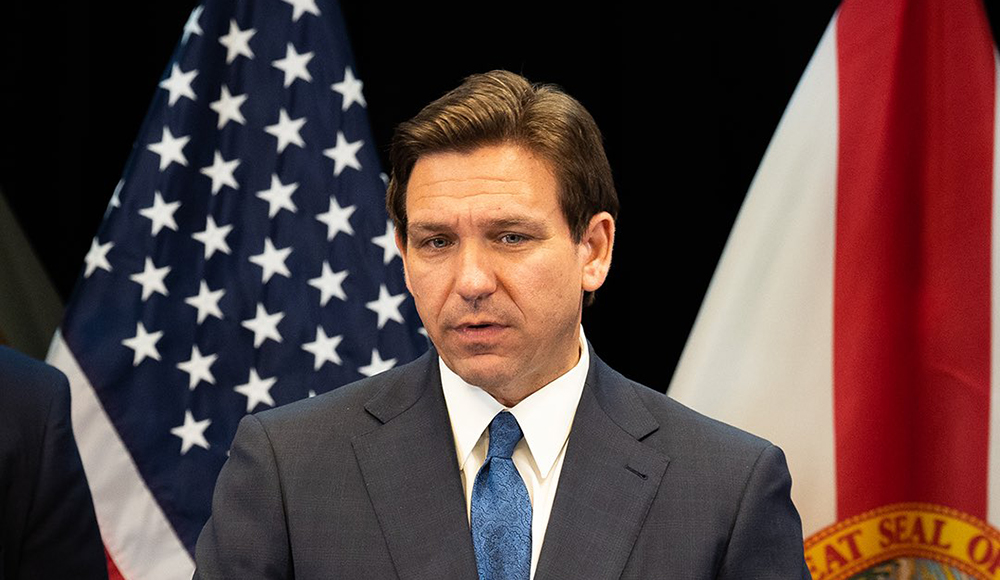
 floridapolitics.com
floridapolitics.com
“I have directed (the Florida State Emergency Response Team) to offer assistance to the State of Maryland, if needed, following the collapse of the Francis Scott Key Bridge. The State of Florida stands willing to help and our prayers are with the victims and first responders,” he said on social media.

Gov. DeSantis offers help to Maryland after bridge collapse
'The State of Florida stands willing to help.'
Laura Loomer is trash.
They are called dolphins. One (or more) was built at the base of new pilings in Tampa Bay during the rebuild of the Sunshine Skyway after the original bridge went down after a vessel hit a support structure. You are smart, but not the first to think that way.
There are 36 of the dolphins around the Sunshine Skyway; they're huge, range from 47 to 64 feet in diameter. The linked article tells the horrifying tale of the 1980 crash/collapse, talks about how difficult the Tampa Bay channel is to navigate, and talks a lot about the new bridge.
The article is from 2007; at that time, almost all of the dolphins have been hit. Around that time, one was hit by a good-sized shrimp boat that sunk after hitting the concrete dolphin.

Skyway Bridge Accident And Collapse - May 9, 1980, Tampa Florida
In light of the Minnesota bridge collapse I wanted to share the mayday called immediately following the Skyway Bridge Collapse on May 9th 1980. The Transcript from the Mayday Call:...
 gcaptain.com
gcaptain.com
What a nightmare all around. Heart breaks for those caught up in this disaster and their families. It's going to be a LONG and expensive recovery from this. I wonder what the actual financial impact of this is going to be.
15 million a day is the number I just saw.
That's not including the cost of the new bridge.
Jiminy!It was at almost this exact spot that the Coast Guard cutter Blackthorn had been rammed four months earlier by the tanker Capricorn. The Blackthorn sank. Twenty-three men died.
Damage to the Blackthorn from the initial impact was not extensive. However, Capricorn's anchor was ready to be let go. The anchor became embedded in the Blackthorn's hull and ripped open the port side above the water line. Then as the two ships backed away from each other, the chain became taut. The force of the much larger ship pulling on it caused Blackthorn to tip on her side until she suddenly capsized. Six off-duty personnel who had mustered when they heard the collision alarm were trapped inside the ship. Several crew members who had just reported aboard tried to escape and in the process trapped themselves in the engine room. Although 27 crewmen survived the collision, 23 perished.
Small potatoes, but when the water drops near the train bridge in Sioux City, large boulders can be seen around the main pillar. I'd assume this is to help redirect a barge that might get too close, or help divert anything for that matter?I’m surprised that large bridges like that don’t have protective pilings around the piers to prevent a direct impact by a large vessel.
There are 36 of the dolphins around the Sunshine Skyway; they're huge, range from 47 to 64 feet in diameter. The linked article tells the horrifying tale of the 1980 crash/collapse, talks about how difficult the Tampa Bay channel is to navigate, and talks a lot about the new bridge.
The article is from 2007; at that time, almost all of the dolphins have been hit. Around that time, one was hit by a good-sized shrimp boat that sunk after hitting the concrete dolphin.

Skyway Bridge Accident And Collapse - May 9, 1980, Tampa Florida
In light of the Minnesota bridge collapse I wanted to share the mayday called immediately following the Skyway Bridge Collapse on May 9th 1980. The Transcript from the Mayday Call:...gcaptain.com
People today have no idea how bad that bridge collapse was. A Greyhound bus full of people went into the water along with more than a few cars.
Baltimore's bridge collapse brings back memories of the 1980 Skyway Bridge collapse in Tampa
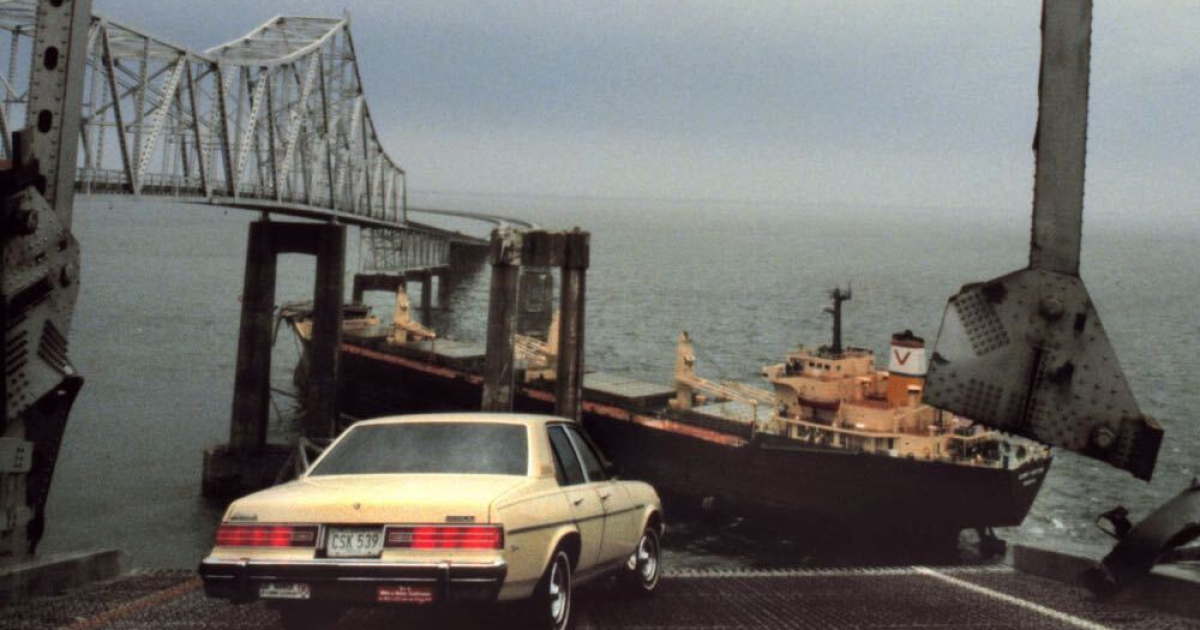
Baltimore's bridge collapse brings back memories of the 1980 Skyway Bridge collapse in Tampa
On May 9, 1980, tragedy struck. A freight ship crashed into the support columns of the Skyway Bridge, causing 1,200 feet of the bridge to collapse. 35 people died that day.
Documentary trailer
The Skyway Bridge Disaster Trailer 2020
Last edited:
One thing I will say for me, and I suspect many other across this land and posting in this thread, is that I had no idea until now how important and big the Port of Baltimore is, having never been to Baltimore.
Compilation of old footage from 1980. It almost immediately mentions the Coast Guard Cutter collision a few months earlier
Archived WTVT coverage: Sunshine Skyway Bridge tragedy
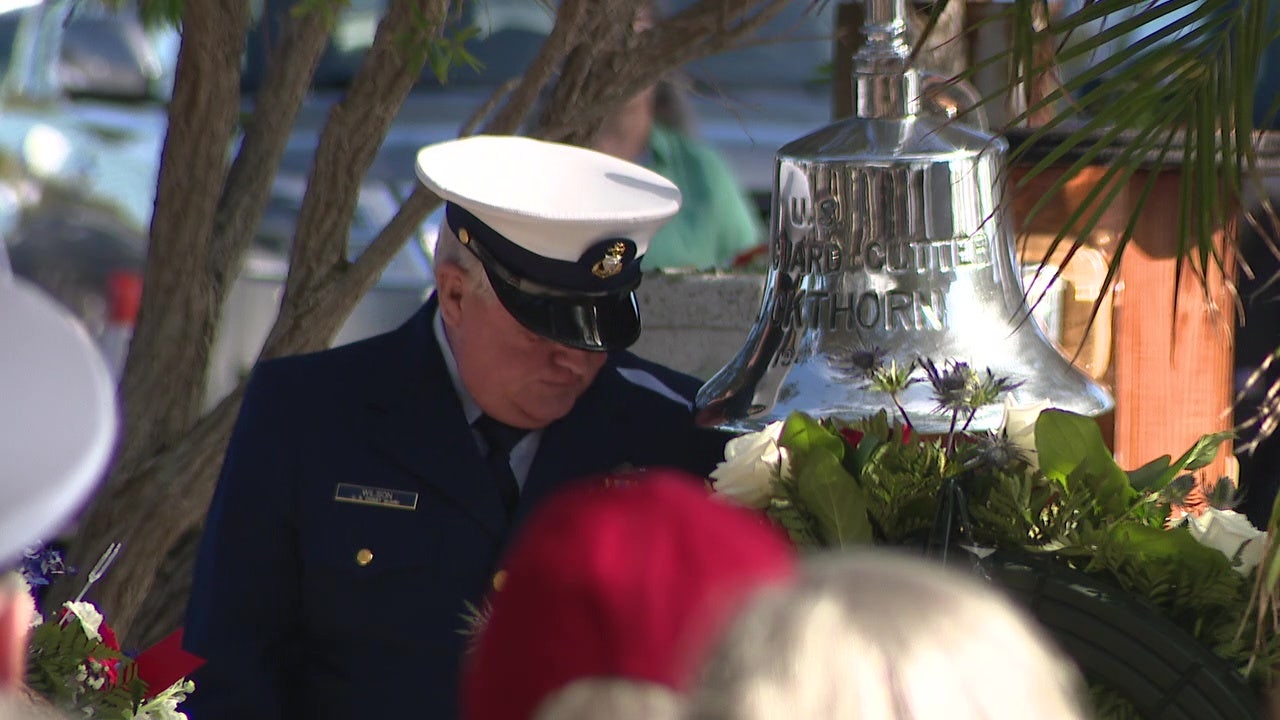
 www.fox13news.com
www.fox13news.com
Archived WTVT coverage: Sunshine Skyway Bridge tragedy
USCG Blackthorn remembered 44 years later

USCG Blackthorn remembered 44 years later
44 years after 23 Coast Guardsmen lost their lives in a collision near the Sunshine Skyway, they are being honored in St. Pete.
Most Americans believe that Abraham Lincoln was our greatest president. Lincoln was also one of America’s greatest lawyers. His folksy style made him a natural as a trial lawyer. He also handled more than 400 appellate cases, most of them in the Illinois Supreme Court and several in the U. S. Supreme Court.This was a massive ship. Honest question here. How much do the fully loaded barges going down the Mississippi River weigh? Apples and Oranges, I know. But is there any chance of something like this happening between Iowa and Louisiana? That would mess up a lot of agriculture.
Brian McGinty, a retired Arizona lawyer, has written three books about Lincoln. His most recent is a spellbinding account of one of Lincoln’s most significant cases, titled Lincoln’s Greatest Case: The River, the Bridge, and the Making of America.
The River is the Mighty Mississippi River. The Bridge is the Rock Island Bridge, the first railroad bridge to cross the Mississippi, built during the years 1853-1856 by a private company called the Railroad Bridge Company. It was 1,581 feet long, built of timber, rested on six stone piers, and stretched from the Illinois community of Rock Island to Davenport, Iowa.
The bridge was officially opened to railroad traffic on April 21, 1856. Two weeks later, on May 6, 1856, a steamboat named Effie Afton, which had begun its voyage in Cincinnati, crashed into one of the piers, caught fire, and was completely destroyed. Fortunately, no one was killed. The bridge was badly damaged, but was repaired and reopened to rail traffic in September 1856.
This horrible accident occurred at a time when railroad companies were beginning to overtake steamboats as the primary mode of transporting people and goods. St. Louis was the steamboat capitol of the United States at that time, and its civic leaders did not favor the ascendancy of the railroads. By contrast, Chicago was emerging as an important rail center for the shipment of goods to the East, and its civic leaders had a very different attitude about railroads.
The civic leaders of St. Louis encouraged the owners of the Effie Afton to file suit against the Railroad Bridge Company, with the hope that a large award of damages would discourage the development of other bridges across the Mississippi. In October 1856, the steamboat owners Jacob S. Hurd, Joseph W. Smith and Alexander W. Kidwell filed suit in the U. S. Circuit Court in Chicago. (At that time, each U. S. Supreme Court justice was assigned to a federal circuit and often served as the trial judge in cases tried in Circuit Court.)
The lead attorney for the Railroad Bridge Company was Norman Judd, a veteran Chicago attorney who had met Lincoln through Illinois politics. Judd decided that Lincoln would be a valuable addition to the defense team, and Lincoln agreed in early July 1857 to become a counsel of record in the case.
The trial judge in this jury trial was Supreme Court Justice John McLean, who had been appointed to the court by Andrew Jackson in 1829. At the time of the trial, he was 71 years old and had served on the Supreme Court for 28 years.
Lincoln’s first task was to obtain a continuance from Justice McLean, so that he and the other defense counsel would have adequate time to prepare for trial. There were 1,100 pages of depositions to review and many witnesses to interview. Justice McLean granted a two-month continuance.
The trial lasted 15 days. The jurors listened to more than 100 witnesses, including a number of expert witnesses. The principal closing argument for the defense was delivered by Attorney Abraham Lincoln.
The overriding issue the jury had to decide was whether the bridge constituted a “material obstruction” to steamboats traveling up and down the Mississippi. If the jury found that it did, the Railroad Bridge Company would have to pay substantial damages to the owners of the Effie Afton.
I don’t want to spoil things for readers by revealing the exact outcome of the case. Suffice it to say that no damages were ever paid to the steamboat owners, and the case resulted in no impediment to the development of rail traffic from West to East.
McGinty’s book is spiced up by the appearance of several historical figures. Rock Island (an island in the river over which the bridge passed) was the site of Fort Armstrong from 1817 to 1836. Assistant Army surgeon Dr. John Emerson took his slave Dred Scott with him to Fort Armstrong, and Scott’s time on the Free Soil of Illinois became the basis of his claim that he was a free man, no longer a slave.
In 1837 a young Army lieutenant named Robert E. Lee surveyed the Rock Island Rapids, just upstream from the bridge, to recommend improvements that would make the river safer for steamboat traffic. In 1854 Secretary of War Jefferson Davis (who wanted to build a railroad bridge over the Mississippi River at a Southern location) persuaded President Franklin Pierce to instruct Attorney General Caleb Cushing to seek a court order ejecting the workers building the bridge from Rock Island on the ground that they had no right of way over the island, which he contended was still a military reservation. It didn’t work. Construction continued to completion.
One of the fact witnesses for the defense was tractor magnate John Deere, who lived on the river in Moline, just north of Rock Island, and was familiar with the currents and cross-currents of the river in the vicinity of the bridge.
Finally, the most interesting tidbit in the book illustrates the extraordinary intellect of our 16th President. Abraham Lincoln is the only American president to hold a patent granted by the U. S. Patent Office — Patent No. 6,469. In the context of this book, it is ironic that this patent is for a method of helping steamboats pass over sandbars without having to remove their cargo.
One thing I will say for me, and I suspect many other across this land and posting in this thread, is that I had no idea until now how important and big the Port of Baltimore is, having never been to Baltimore.
Yeah. Definitely didn’t have it as the largest auto port in US
People today have no idea how bad that bridge collapse was. A Greyhound bus full of people went into the water along with more than a few cars.
Baltimore's bridge collapse brings back memories of the 1980 Skyway Bridge collapse in Tampa

Baltimore's bridge collapse brings back memories of the 1980 Skyway Bridge collapse in Tampa
On May 9, 1980, tragedy struck. A freight ship crashed into the support columns of the Skyway Bridge, causing 1,200 feet of the bridge to collapse. 35 people died that day.www.abcactionnews.com
Documentary trailer
The Skyway Bridge Disaster Trailer 2020
The article I linked talks some about the guys in this car - I'd imagine they're interviewed in the documentary. Might be the luckiest SOBs ever...
Let’s get some over unders on how long it takes to clear the ship? Demo and reopen shipping channel?
Thanks, Lute.Most Americans believe that Abraham Lincoln was our greatest president. Lincoln was also one of America’s greatest lawyers. His folksy style made him a natural as a trial lawyer. He also handled more than 400 appellate cases, most of them in the Illinois Supreme Court and several in the U. S. Supreme Court.
Brian McGinty, a retired Arizona lawyer, has written three books about Lincoln. His most recent is a spellbinding account of one of Lincoln’s most significant cases, titled Lincoln’s Greatest Case: The River, the Bridge, and the Making of America.
The River is the Mighty Mississippi River. The Bridge is the Rock Island Bridge, the first railroad bridge to cross the Mississippi, built during the years 1853-1856 by a private company called the Railroad Bridge Company. It was 1,581 feet long, built of timber, rested on six stone piers, and stretched from the Illinois community of Rock Island to Davenport, Iowa.
The bridge was officially opened to railroad traffic on April 21, 1856. Two weeks later, on May 6, 1856, a steamboat named Effie Afton, which had begun its voyage in Cincinnati, crashed into one of the piers, caught fire, and was completely destroyed. Fortunately, no one was killed. The bridge was badly damaged, but was repaired and reopened to rail traffic in September 1856.
This horrible accident occurred at a time when railroad companies were beginning to overtake steamboats as the primary mode of transporting people and goods. St. Louis was the steamboat capitol of the United States at that time, and its civic leaders did not favor the ascendancy of the railroads. By contrast, Chicago was emerging as an important rail center for the shipment of goods to the East, and its civic leaders had a very different attitude about railroads.
The civic leaders of St. Louis encouraged the owners of the Effie Afton to file suit against the Railroad Bridge Company, with the hope that a large award of damages would discourage the development of other bridges across the Mississippi. In October 1856, the steamboat owners Jacob S. Hurd, Joseph W. Smith and Alexander W. Kidwell filed suit in the U. S. Circuit Court in Chicago. (At that time, each U. S. Supreme Court justice was assigned to a federal circuit and often served as the trial judge in cases tried in Circuit Court.)
The lead attorney for the Railroad Bridge Company was Norman Judd, a veteran Chicago attorney who had met Lincoln through Illinois politics. Judd decided that Lincoln would be a valuable addition to the defense team, and Lincoln agreed in early July 1857 to become a counsel of record in the case.
The trial judge in this jury trial was Supreme Court Justice John McLean, who had been appointed to the court by Andrew Jackson in 1829. At the time of the trial, he was 71 years old and had served on the Supreme Court for 28 years.
Lincoln’s first task was to obtain a continuance from Justice McLean, so that he and the other defense counsel would have adequate time to prepare for trial. There were 1,100 pages of depositions to review and many witnesses to interview. Justice McLean granted a two-month continuance.
The trial lasted 15 days. The jurors listened to more than 100 witnesses, including a number of expert witnesses. The principal closing argument for the defense was delivered by Attorney Abraham Lincoln.
The overriding issue the jury had to decide was whether the bridge constituted a “material obstruction” to steamboats traveling up and down the Mississippi. If the jury found that it did, the Railroad Bridge Company would have to pay substantial damages to the owners of the Effie Afton.
I don’t want to spoil things for readers by revealing the exact outcome of the case. Suffice it to say that no damages were ever paid to the steamboat owners, and the case resulted in no impediment to the development of rail traffic from West to East.
McGinty’s book is spiced up by the appearance of several historical figures. Rock Island (an island in the river over which the bridge passed) was the site of Fort Armstrong from 1817 to 1836. Assistant Army surgeon Dr. John Emerson took his slave Dred Scott with him to Fort Armstrong, and Scott’s time on the Free Soil of Illinois became the basis of his claim that he was a free man, no longer a slave.
In 1837 a young Army lieutenant named Robert E. Lee surveyed the Rock Island Rapids, just upstream from the bridge, to recommend improvements that would make the river safer for steamboat traffic. In 1854 Secretary of War Jefferson Davis (who wanted to build a railroad bridge over the Mississippi River at a Southern location) persuaded President Franklin Pierce to instruct Attorney General Caleb Cushing to seek a court order ejecting the workers building the bridge from Rock Island on the ground that they had no right of way over the island, which he contended was still a military reservation. It didn’t work. Construction continued to completion.
One of the fact witnesses for the defense was tractor magnate John Deere, who lived on the river in Moline, just north of Rock Island, and was familiar with the currents and cross-currents of the river in the vicinity of the bridge.
Finally, the most interesting tidbit in the book illustrates the extraordinary intellect of our 16th President. Abraham Lincoln is the only American president to hold a patent granted by the U. S. Patent Office — Patent No. 6,469. In the context of this book, it is ironic that this patent is for a method of helping steamboats pass over sandbars without having to remove their cargo.
The article I linked talks some about the guys in this car - I'd imagine they're interviewed in the documentary. Might be the luckiest SOBs ever...
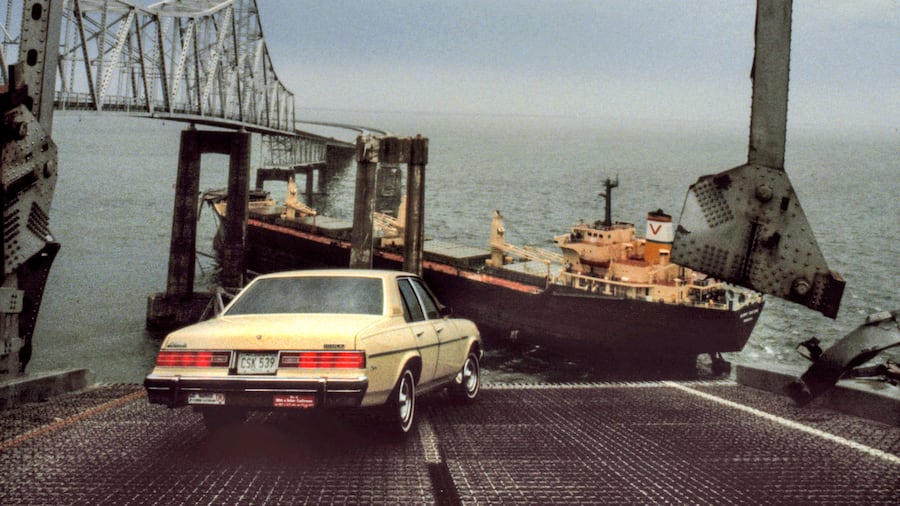
I just read the article. It’s very well written.
2 dolphins near the Blackhawk bridge in Lansing. Not sure what the one closest to the shore is for, that is WAY off the main channel. Maybe to "catch" a barge or tug. Hardest turn on the Mississippi.
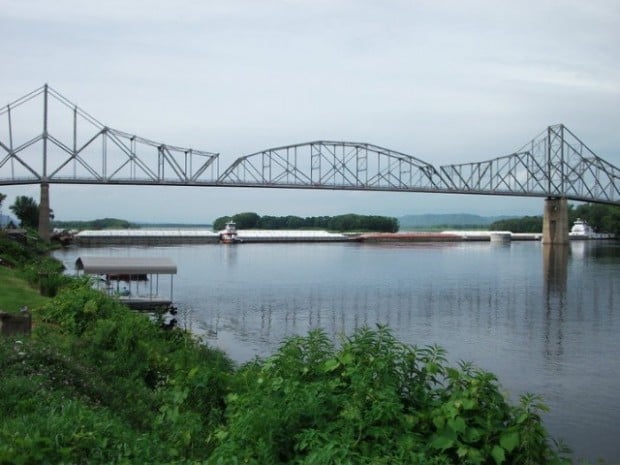

I think re-opening the channel happens PDQ.Let’s get some over unders on how long it takes to clear the ship? Demo and reopen shipping channel?
Things holding up money get money spent to fix them fast.
This is holding up a lot of money.
ScouringSmall potatoes, but when the water drops near the train bridge in Sioux City, large boulders can be seen around the main pillar. I'd assume this is to help redirect a barge that might get too close, or help divert anything for that matter?
My thoughts too. ^^ I don't know enough about the physics of removing the debris, but it would seem like it would not take long to clear a lane and there will be plenty of focus on doing it ASAP.I think re-opening the channel happens PDQ.
Things holding up money get money spent to fix them fast.
This is holding up a lot of money.
I was hoping that was the case. Too bad they couldn't communicate with the crew that was working.
Yeah, except DeSantis didn't hold Skanska accountable for letting their barges destroy the 3 mile bridge in Pensacola. DeSantis has become more and more glitter over substance. He needs to manage his own DOT. Civil contractors in Florida get away with murder.Gov. Ron DeSantis is extending state resources, should they be needed, to Maryland in the wake of the shocking collapse of a bridge in Baltimore.
“I have directed (the Florida State Emergency Response Team) to offer assistance to the State of Maryland, if needed, following the collapse of the Francis Scott Key Bridge. The State of Florida stands willing to help and our prayers are with the victims and first responders,” he said on social media.

Gov. DeSantis offers help to Maryland after bridge collapse
'The State of Florida stands willing to help.'floridapolitics.com
Biden said last night that he had traveled that bridge many times by car and train.
Yeah, Joe, but trains don't cross that bridge.
Yeah, Joe, but trains don't cross that bridge.
This was a massive ship. Honest question here. How much do the fully loaded barges going down the Mississippi River weigh? Apples and Oranges, I know. But is there any chance of something like this happening between Iowa and Louisiana? That would mess up a lot of agriculture.
Breakaway barges have caused a great deal of damage in the past to bridges on the Mississippi. Especially the wooden protection piers of swinging railroad bridges. Lock and Dam 11 in Dubuque was hit by loose barges several years ago during the flood, but the damage was minimal. Fortunately, barge shipping on the Mississippi has tugs available everywhere for assistance under bridges or through tight areas. Another benefit is that unlike a container ship, a river captain pushing barges can and will force land them against a bank if a problem occurs. Barges are designed to allow for that.
When you roll thru there North or South, it is amazing to see all of the constant activity.One thing I will say for me, and I suspect many other across this land and posting in this thread, is that I had no idea until now how important and big the Port of Baltimore is, having never been to Baltimore.
Naval vessels. The countries largest system for importing vehicles. Vast piles of fertilizer (?) other resources, moved via various methods, …
I mostly travel the 895 tunnel, (a bit West of the Key Bridge) but do others as needed.
Just as DC is a huge choke point for NorthSouth travel, Baltimore City is such for cargo.
Baltimore has always taken pride in being a “working mans” place. They get it done.
Stopping for grub at local joints, you feel the local pride.
Last edited:
Skanska is a law firm acting as contractors.Yeah, except DeSantis didn't hold Skanska accountable for letting their barges destroy the 3 mile bridge in Pensacola. DeSantis has become more and more glitter over substance. He needs to manage his own DOT. Civil contractors in Florida get away with murder.
They totally screwed the pooch on a new Science/Stem building at WCU that my company was involved with. They are not efficient at building, but slick about accountability.
Last edited:
Let’s get some over unders on how long it takes to clear the ship? Demo and reopen shipping channel?
I don't see it cleaned up in 12 months. Of course I didn't stay at a Motel 6 last night.....
I expect the harbor to be operational in a few months. The bridge… hell fire. Pick a number, any number.I don't see it cleaned up in 12 months. Of course I didn't stay at a Motel 6 last night.....
Similar threads
- Replies
- 13
- Views
- 282
- Replies
- 7
- Views
- 286
- Replies
- 1
- Views
- 121
- Replies
- 3
- Views
- 118
ADVERTISEMENT
ADVERTISEMENT

